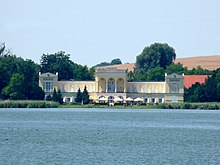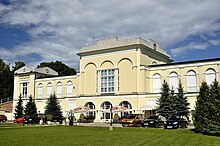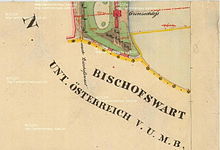Border lock
The border castle ( Czech : Hraniční Zámeček ) is a castle that connects the parks of the castles Valtice (German: Feldsberg Castle ) and Lednice (German: Eisgrub Castle ), now in the Czech Republic . It is part of the Lednice-Valtice cultural landscape and thus the UNESCO World Heritage of the same name .
Geographical location
The border castle is located north of the village of Hlohovec ( Bischofswarth ) on the former border between Lower Austria and Moravia . It was placed exactly so that the border parted it in the middle. It is located on the banks of the Bischofwarther pond and is almost exactly aligned in an east-west direction.
history
From the Middle Ages until the end of the First World War , the border between Moravia and Lower Austria ran directly through the ponds south of Lednice. Prince Johann I Josef von Liechtenstein had the castle built here between 1824 and 1827, as he owned the rulers on both sides of the border, Eisgrub in Moravia and Feldsberg in Lower Austria. Its architect was Joseph Franz Engel , who fell seriously ill in 1825. The work was then mainly carried out by Joseph Poppelsack .
After the First World War, the proposed Treaty of Saint-Germain , the previously belonging to Lower Austria Feldberger country of Czechoslovakia to. In contrast to the previous state border, the state border now ran significantly further south. In the interwar period, a bunker for the Czechoslovak border fortifications was built into the southern driveway of the castle .
After Austria was annexed to Germany, the Munich Agreement was concluded in 1938 , with which Czechoslovakia had to cede the predominantly German-speaking areas to Germany. The new state border, which came into effect at the beginning of October 1938, was now north of Lednice, with the result that the entire Lednice-Valtice cultural landscape came to lie on German territory. After the Second World War , all of this was revised and reverted to the state of 1919.
Today the castle houses a restaurant and a hotel.
building
The building makes reference to the original border location in several places: In the cornice of the attic there are the inscriptions Between Austria and Moravia and Gränzmahl between Austria and Moravia , the coats of arms of both countries adorn the respective side and a pair of domes above the central hall on the ground floor make reference on this particular location. The national border was further marked by a watercourse that gushes out of a nymph's amphora in the garden , flows through the structure and pours into the Bischofwarther pond.
The foundation of the structure was difficult, as it was erected on the muddy bank area of the Bischofwarther pond, and was carried out on wooden posts and gratings. The castle consists of a larger central pavilion, a smaller pavilion on the left and right. These three elements are two-story and are connected by single-story communication wings. These in turn have a blind arcade on the second floor on the land side and a roof terrace on the lake side.
See also
literature
- Pavel Zatloukal (eds.), Pŕemysl Krejčiŕik and Ondŕej Zatloukal: The Lednice-Valtice Cultural Landscape . Foibos Books, Prague 2012.
Web links
Remarks
- ↑ There have been doubts about the authorship of Joseph Franz Engel. However, stylistic features also point to it. (Zatloukal: The cultural landscape , p. 130).
Individual evidence
- ↑ a b c d Zatloukal: Die Kulturlandschaft , p. 128.
- ^ Zatloukal: Die Kulturlandschaft , p. 36.
- ^ Zatloukal: The cultural landscape , p. 129f.
Coordinates: 48 ° 46 ′ 49.1 ″ N , 16 ° 45 ′ 28.2 ″ E



